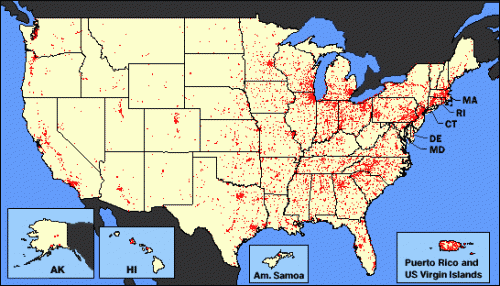Unsafe water is not limited to poor countries only, or to “third world” countries, as they are called nowadays, but one of the richest and most powerful countries, is suffering from polluted water, that could barely be drunken. Would you believe that the U.S. is suffering from that problem?
According to a new research, which was published yesterday in the journal Environmental Science & Technology Letters, millions of Americans may be drinking water with unsafe levels of industrial chemicals.
Levels of a widely used class of industrial chemicals linked with cancer and other health problems — polyfluoroalkyl and perfluoroalkyl substances (PFASs) — exceed federally recommended safety levels in public drinking-water supplies for 6 million people in the United States, according to the new study led by researchers from the Harvard T.H. Chan School of Public Health and the Harvard John A. Paulson School of Engineering and Applied Sciences (SEAS).
These chemicals, known as polyfluoroalkyl and perfluoroalkyl substances or PFASs, have been linked to high cholesterol, obesity, hormone suppression, and even cancer. Introduced more than 60 years ago, PFASs are a category of man-made chemicals that degrade very slowly, if at all, in the environment, The Telegraph reported.
“For many years, chemicals with unknown toxicities, such as PFASs, were allowed to be used and released to the environment, and we now have to face the severe consequences,” said lead author Xindi Hu, a doctoral student in the Department of Environmental Health at Harvard Chan School, Environmental Science and Engineering at SEAS, and Graduate School of Arts and Sciences.
“In addition, the actual number of people exposed may be even higher than our study found, because government data for levels of these compounds in drinking water is lacking for almost a third of the U.S. population — about 100 million people.”
The researchers looked at concentrations of six types of PFASs in drinking-water supplies, using data from more than 36,000 water samples collected nationwide by the U.S. Environmental Protection Agency (EPA) from 2013 to 2015.
They also looked at industrial sites that manufacture or use PFASs; at military fire-training sites and civilian airports where firefighting foam containing PFASs is used; and at wastewater-treatment plants. Discharges from these plants — which are unable to remove PFASs from wastewater by standard treatment methods — could contaminate groundwater. So could the sludge the plants generate, which is frequently used as fertilizer.
The study found that:
- PFASs were detectable at the minimum reporting levels required by the EPA in 194 out of 4,864 water supplies in 33 states across the United States
- Drinking water from 13 states accounted for 75 percent of the detections: California, New Jersey, North Carolina, Alabama, Florida, Pennsylvania, Ohio, New York, Georgia, Minnesota, Arizona, Massachusetts, and Illinois, in order of frequency of detection
- Sixty-six of the public water supplies examined, serving 6 million people, had at least one water sample that measured at or above the EPA safety limit of 70 parts per trillion (ng/L) for two types of PFASs, perfluorooctanesulfonic acid (PFOS) and perfluorooctanoic acid (PFOA)
- Concentrations ranged as high as 349 ng/L for PFOA (Warminster, Pa.) and 1,800 ng/L for PFOS (Newark, Del.)
- The highest levels of PFASs were detected in watersheds near industrial sites, military bases, and wastewater-treatment plants.
“These compounds are potent immunotoxicants in children and recent work suggests drinking-water safety levels should be much lower than the provisional guidelines established by EPA,” said Elsie Sunderland, senior author of the study and associate professor at both the Harvard Chan School and SEAS.
What is EPA doing regarding these chemicals?
EPA has taken a range of regulatory actions to address PFAS substances in manufacturing and consumer products as noted below. In addition, EPA developed and industry implemented a global stewardship program with the goal of eliminating these chemicals from emissions and products by 2015.
Click here to view EPA’s Drinking Water Health Advisories for PFOA and PFOS.
USA fresh water pollution map.
Water, the vital element of life, is becoming more scarce. Not only that, but in many parts of the world, it is becoming more polluted. We are aware that not all humans get the same attention even if they has the same cause. Water pollution and scarcity in third world countries might be just another news to read and continue our lives normally, but if these (Water pollution and scarcity) were happening in the U.S., then it is something serious.
Knowing that pollution not only affects the environment and people’s health, but also affects the economy, how will this study change the water treatment methods in the U.S. or any other part in the world?
In 2008, researchers found that freshwater pollution by phosphorous and nitrogen costs government agencies, drinking water facilities and individual Americans at least $4.3 billion annually. Of that, they calculated that $44 million a year is spent just protecting aquatic species from nutrient pollution. That was in 2008… the number increased with increased pollution levels, as many studies show, and with the recent study we published…. it is revealed that the problem is getting worse by the day…












